PDF of this article (259 KB)
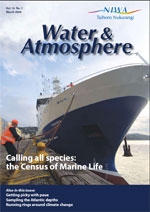
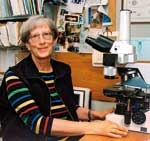
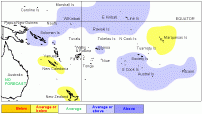
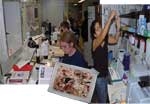

As part of the Census of Marine Life, an international collaboration of plankton specialists has joined forces under the banner ‘Census of Marine Zooplankton’, or CMarZ. Janet Grieve describes their research voyage down the Atlantic coast of Africa.
What lies beneath? To find out, a group of 30 researchers hitched a ride aboard PFS Polarstern from Bremerhaven, Germany, to Capetown, South Africa, as the ship headed south for the Antarctic research season. Our mission was to study zooplankton throughout the entire water column (from the surface to the seabed) to depths greater than 4000 m. We were intent on investigating waters south of the equator, with a particular focus on the poorly known mesopelagic (middle depth) and bathypelagic (deepest) realms. Our plan was to identify the zooplankton species genetically while still at sea, as we coasted along Africa from late October to late November 2007.
The team had participants from Canada, Chile, Germany,Japan, Mexico, New Zealand, Poland, Spain, The Netherlands, UK, and USA. There were 16 people under the age of 30, although it was noticeable that several experts on board were retired or near retirement.
All at sea
The research concentrated on analysing the samples on the ship, and our scientific team included taxonomic experts, molecular specialists, and students. We collected zooplankton with two sizes of the MOCNESS and used the MultiNet for vertical collections (see ‘Gearing up’). We analysed the samples using traditional taxonomic approaches and molecular systematic analysis, including DNA sequencing of a target gene portion for each species. The US contingent provided the sea-going DNA laboratory, including all of the equipment needed to carry out gene sequencing of identified species.
And back on land
Follow-up molecular analysis and expert taxonomic evaluation and description of any new or undescribed species will be made in association with the CMarZ Taxonomic Network. The material will be held in two places: alcohol-preserved samples at the Alfred Wegener Institute for Marine and Polar Research in Bremerhaven, and the formalin-preserved samples atWoods Hole Oceanographic Institute in Massachusetts, USA. All these samples will be available for research.
Gearing up
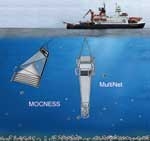
MOCNESS – Multiple Opening Closing Nekton Ecological Sampling System – is a stacked arrangement of fine-meshed nets towed behind a ship. The net system carries a flow meter and pressure, temperature, and salinity sensors which transmit their data back to the ship. The nets can be opened and closed at different depths, thus collecting the small animals (zooplankton) that drift with the ocean’s currents within the water column.
For the CMarZ project we used two sizes of MOCNESS. One had a 1 m2 mouth opening and nine nets (for sampling from the surface to 1000 m depth) and the other had a 10 m2 mouth opening and five nets (for sampling 1000–4000 m depth). These nets had fine meshes of 0.335 mm.
MultiNet – as the name suggests, also contains a stack of nine nets but operates slightly differently. This net, with a 0.5 m2 mouth opening, was hauled vertically and had a very fine mesh size of 0.150 mm. This net was also used from the surface to 1000 m depth.
PFS Polarstern – is the 118-m research icebreaker operated by the Alfred Wegener Institute as a floating laboratory for work in polar regions.
All in a day’s work
Samples were taken from deeper than 4000 m in the deep basins at five stations (red dots on the map) from PFS Polarstern. The vessel was ideal for this purpose as it has 8500 m of conducting cable which could tow the MOCNESS down to near the sea floor. The depth, salinity, and temperature were recorded in real time and transmitted back to the vessel along the conducting cable and were displayed in the laboratory.
Sampling the whole water column took almost a full day. The deep tows between 1000 m and more than 4000 m depth took 8–10 hours to get the net down and the layered samples back on board.
There was great excitement each time the deep nets came up full of large colourful zooplankton. Bright red and black colouration was common although many of the smallest crustaceans were perfectly transparent. We sorted out the largest animals in the cold rooms, then the specimens were photographed.
Fractions of the sample were preserved in 95% ethanol and 4% formalin. Samples were then successivelyworked on in the shipboard laboratories to record all the data and identify species for genetic analysis.
A dusty footnote
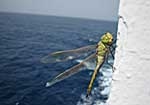
Although the ship was more than 320 km offshore, a dust storm from the Sahara reached the ship along with many insects – shield bugs, grasshoppers, and large dragonflies. This event lasted for several days. We know that after the dust storm we carried stowaway grasshoppers all the way to Capetown, as we could hear them chirping in the ventilation system for the remainder of the voyage.
Research on the move
- The Census of Marine Zooplankton group has sampled deep waters off the African coast.
- In addition to the usual taxonomic identifications, they also began DNA analysis of the samples while still at sea.
- 471 species were identified on board from more than 65 000 specimens sorted during the voyage.
Useful links
Census of Marine Zooplanton: www.cmarz.org
Census of Marine Life: www.coml.org
Dr Janet Grieve is a NIWA emeritus researcher and member of the CMarZ Steering Committee. As a result of the voyage, she has already written her part of a paper describing a new calanoid copepod species in a rare family of Hyperbionychidae. This work will be in collaboration with Professor Ann Bucklin’s team at the University of Connecticut, who will contribute the genetic analyses.
Support for CMarZ and the Polarstern voyage was provided by the Alfred P. Sloan Foundation, the Alfred Wegener Institute for Polar and Marine Research, and the NOAA Office of Ocean Exploration.
Teachers’ resource for NCEA Achievement Standards or Unit Standards: Biology Level 1 AS90162 Science Level 1 US6349, AS90187, Level 2 AS90771
